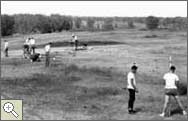|
|
 |
 |
 |
|
The Puzzle of the Past |
|
Introduction
-
The Puzzle of the Past
-
Site Seeing
-
Digging in the Dirt
-
Interpreting the Evidence
-
Decoding the Past
|
 |
 |
 |

The human past is like a vast, uncompleted jigsaw puzzle with many scattered pieces. To a historian, the pieces of this puzzle are letters, journals, books, and maps — in short, the whole host of written documents that have survived over time. Documents might be as rare as an original copy of the Declaration of Independence or as common as the daily newspaper. An archaeologist searches for different pieces of this same puzzle. However, rather than seek what has been written, he or she looks for what has been left behind — in the form of artifacts (human-made objects) and other evidence of past human activity.
Finding written records of history is different from discovering archaeological puzzle pieces. A historian might know where to look for a potentially important document — perhaps in an archive or a collection of personal papers. In comparison, an archaeologist usually has fewer leads but just as many ways of learning about the past.
|
 |
 |
 |
 |

Smithsonian archaeologists survey a site (Garrison Reservoir, North Dakota).
|
 |
 |
 |
|




|
|
|

